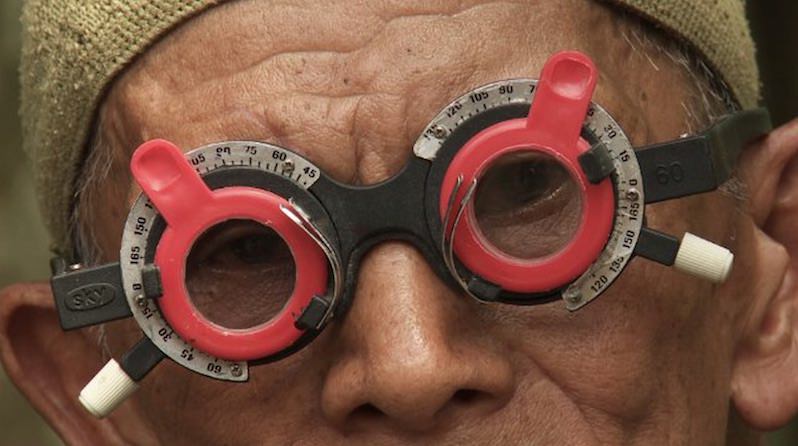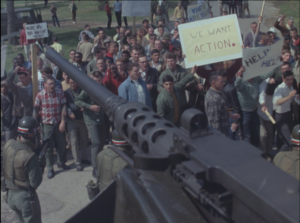‘The Look of Silence’: Showing the Human Side of Genocide
What if the Nazis had won in World War II? That question represents one of the thematic forces that shape Joshua Oppenheimer’s quietly riveting, Oscar-nominated documentary about Indonesia's 1965-66 tragedy. IMDb
IMDb
This is a reprinted review on “The Look of Silence” in honor of the documentary’s recent Oscar nomination. The 88th Academy Awards will air on Sunday, February 28, 2016.
What if the Nazis had won? That question represents one of the thematic forces that shape Joshua Oppenheimer’s quietly riveting new documentary, “The Look of Silence.”
Oppenheimer pushes his investigation even further in a 103-minute meditation on how those most affected by the ravages of genocide learn to live among their loved ones’ killers. Here, the perpetrators of Indonesia’s massacres 50 years ago are still in power.
Another apt name for the film could have been “The Intimacy of Violence.” But silence deserves top billing in this companion piece to Oppenheimer’s last outing, “The Act of Killing,” the hyperreal waking nightmare he co-directed using the same source material: politically motivated mass murder. Silence plays many roles in his follow-up, offering cover to criminals and solace to victims, pacing loaded scenes, at times providing the only possible response to what appears on the screen.
Though the two films deal with the idea of impunity writ large, and they range in scope far beyond their setting, the specific tragedy they trace is unfathomable in scale and essential in detail. The American documentarian, with the help of executive producers Erroll Morris and Werner Herzog, as well as a filmmaking team that lists several anonymous members among the credits, takes as his subject the slaughter of hundreds of thousands, if not millions, of Indonesians half a century ago. Those killings were pinned on lies, which the U.S. government was complicit in supporting and which Oppenheimer is clearly invested in exposing, about a “communist threat” to the country that effectively paved a bloody path for Suharto’s regime to take control.
READ: Chris Hedges: The Act of Killing
“Silence” grew out of the former project in spirit and substance. The story revolves around 44-year-old optician Adi Rukun, who has spent his life shadowed by his brother Ramli’s murder by members of Indonesia’s paramilitary death squads. As his heartbroken mother frequently reminds him, Adi’s birth saved her from completely losing her mind along with her first son. (Still, Oppenheimer’s camera picks up signs that neither of Adi’s parents was able to sustain that blow, and despite Adi’s best caretaking efforts, one of them drifts away into a haze of fear.)
Ramli was sadistically murdered by paramilitary henchmen, his broken body becoming a physical symbol of unspeakable atrocity in his village by virtue of being buried in an actual grave. Most of the others butchered by the same hands were tossed in the nearby Snake River, which acts as a visual refrain throughout the film, alternately suggesting buoyancy, relentlessness, menace and peace.
It was also the place where Ramli met his end. Oppenheimer records two local executioners chumming it up on the riverbank and bragging in lurid detail about Ramli’s death, and that footage becomes the focus for Adi and the audience in other key scenes.
Adi wants answers from the sources of his family’s grief, and he’s willing to put his own life on the line to get them. That code-red threat is sometimes hinted at, and more than once spelled out, during the mostly polite interviews he conducts in the living rooms of his brother’s killers. Some of them are politicians, another is even Adi’s uncle, but one by one they shirk personal responsibility for Ramli’s slaying.
When Adi reveals the true reason for his visit, their smooth talk quickly becomes bureaucratically evasive or dangerously pointed, or both. There are moments when it is all too clear that these conversations may have turned out differently if not for the presence of the filmmakers and their equipment—but then, without them, perhaps the confrontations wouldn’t have taken place at all. In exchange for their trouble, Adi offers his subjects eye exams, helping them pick the frames best suited for their faces. Since the notion of accountability is vital in “The Look of Silence,” the issue of mortal danger for Adi, as well as for his wife, son, daughter and parents, arises repeatedly over the course of his quest. His mother and wife voice the concerns that Oppenheimer is obliged to consider in his position, and one of the film’s blind spots, as well as a source of its strength, has to do with what isn’t overtly addressed.
We don’t know, just by watching, if there’s an element of recklessness to the overall project—whether Oppenheimer is parachuting in to peer into others’ lives, or what might happen to Adi once Oppenheimer packs up and leaves for his home base in Denmark (and in fact, the filmmaker has said he will not return to Indonesia). The documentary also doesn’t relay how, despite the risks, Adi was bent on making “Silence” in order to honor his parents and Ramli—and maybe even to change the country his children inherit.
But Oppenheimer persuasively filled in those gaps himself during a recent screening at the University of Southern California’s School of Cinematic Arts in Los Angeles. The respectful tone he maintains behind the camera was also reflected in his comments about Adi, whose circumstances have changed dramatically, as well as the agents of the 1965-66 mass killings. Gesturing at Nazism and other man-made disasters, he insisted, “We have to understand how perpetrators commit these acts,” adding that he and Adi believed the way to do that was to exercise the “widest possible human empathy.”
Ultimately, the film’s deepest undercurrent isn’t journalistic so much as poetic, and in that sense it succeeds beautifully. Whereas “Killing” projects the splintered psyches of death squad leaders onto the screen in garish excess, its sequel is an equally indelible study in harrowing understatement seen through the lens of survivors. You can’t un-see either movie, and that’s a good thing.
What can’t be put into words can still be shown, and “Silence” works hard to humanize the genocidal riddle. As Oppenheimer pointed out, these killers were people who were forced to discover what they were capable of, and later how to forget it all. Meanwhile, he said, “We are very lucky never to have to find that out.”
Your support matters…Independent journalism is under threat and overshadowed by heavily funded mainstream media.
You can help level the playing field. Become a member.
Your tax-deductible contribution keeps us digging beneath the headlines to give you thought-provoking, investigative reporting and analysis that unearths what's really happening- without compromise.
Give today to support our courageous, independent journalists.






You need to be a supporter to comment.
There are currently no responses to this article.
Be the first to respond.